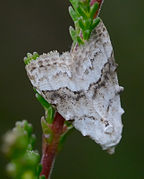Nola aerugula
| Nola aerugula | |
|---|---|

| |
| Adult | |
| Scientific classification | |
| Domain: | Eukaryota |
| Kingdom: | Animalia |
| Phylum: | Arthropoda |
| Class: | Insecta |
| Order: | Lepidoptera |
| Superfamily: | Noctuoidea |
| Family: | Nolidae |
| Genus: | Nola |
| Species: | N. aerugula
|
| Binomial name | |
| Nola aerugula (Hübner, 1793)
| |
| Synonyms[1] | |
|
List
| |
Nola aerugula, the scarce black arches, is a moth of the family Nolidae found in Asia and Europe. The species was first described by the German entomologist, Jacob Hübner in 1793.
Subspecies[edit]
- Nola aerugula aerugula
- Nola aerugula holsatica Sauber, 1916 (Denmark, the Netherlands) – many authors consider holsatica to be a full species.[2]
Description[edit]
The wingspan is 15–20 mm. These small drab moths show quite variable colors and patterns. The basic color may be gray, brownish or almost white, with brown transverse bands. There are also bright and dark specimens with high-contrast patterns. Forewings are almost triangular with a rounded basal area. The rear wings are gray or brownish. The body is cylindrical. The antennas are filamentous, about half as long as forewings.
Biology[edit]
Adults are on wing from June to August in one generation. Males begin to fly just before sunset, and can sometimes be seen in swarms in search of females. The larvae mainly feed on clover (Trifolium) and common bird's-foot trefoil (Lotus corniculatus), but also birch (Betula species), willow (Salix species) and poplar (Populus species). The larvae of ssp. holsatica feed on petty whin (Genista anglica) and hairy greenweed (Genista pilosa). Larvae overwinter, and can be found from August to June. Pupation takes place in a cocoon,on the ground or attached to the host plant just above the ground.[3][4]
Habitat[edit]
This species lives on sandy areas and peatlands.
Distribution[edit]
This species can be found in most of Europe, east to eastern Asia and Japan.[5][6] A former resident in Kent it is nowadays a rare migrant to Great Britain.[7]
Taxonomy[edit]
In 1793, Hübner placed the moth in the obsolete genus Phalaena, which was raised by Carl Linnaeus to house most of the moths. The English zoologist William Elford Leach Leach raised the genus Nola in 1815 and placed it in the Tortricidae family. The genus is possibly named after the town in Campania, Italy. This was one of the earliest examples of using a place for the name of a genus, although he did not give an explanation as to why he chose Nola. It was one of the earliest examples of using a place for the name of a genus. Hübner named the moth aerugula from aerugo – the rust of copper. There is no trace of green colouration and the intended meaning is probably 'coppery' – referring to the pale brown colour on the forewing.[8]
Gallery[edit]

-
Moth
-
Mounted specimen
References[edit]
- ^ "Art: Nola aerugula - vitpucklig trågspinnare". Dyntaxa. Retrieved 14 July 2023.
- ^ "Nola aerugula (Hübner)". GBIF. Retrieved 14 July 2023.
- ^ " Nola aerugula (Hübner, 1793)". Catalogue of the Lepidoptera of Belgium. Retrieved 14 July 2023.
- ^ "Nola aerugula (HÜBNER, 1793)". Euroleps. Retrieved 14 July 2023.
- ^ "Nola aerugula (Hübner, 1793)". Fauna Europaea. Retrieved 14 July 2023.
- ^ Savela, Markku (May 18, 2020). "Nola aerugula (Hübner, 1793)". Lepidoptera and Some Other Life Forms. Retrieved August 6, 2020.
- ^ Kimber, Ian. "Scarce Black Arches Nola aerugula (Hübner, 1793)". UKmoths. Retrieved 14 July 2023.
- ^ Emmet, A Maitland (1991). The Scientific Names of the British Lepidoptera. Their History and Meaning. Colchester: Harley Books. p. 194-5. ISBN 0 946589 28 3.
External links[edit]
- Lepiforum e. V.
- Mazzei, Paolo; Morel, Daniel & Panfili, Raniero. "Nola aerugula (Hübner, [1793])". Moths and Butterflies of Europe and North Africa. Retrieved August 6, 2020.


